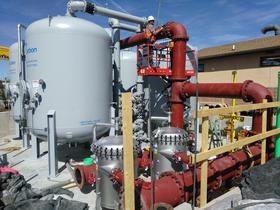Water - FAQ
Update May 4, 2017
The District team has completed the pilot testing, design, and construction of our new PFC Removal Plant! Testing and start up has been occurring all week at the new facility. WWSD has the first PFC Ion Exchange Removal Plant in America!
Picture of PFC Treatment Facility:

Update On Epas New Lower Combined Pfc Health Advisory Level
Please see information released by Colorado Department of Public Heatlh and Environment on 6/30/2016 regarding the PFC preliminary assessment of Cancer and Birth Outcomes:
CDPHE Southeast El Paso County PFC Preliminary Assessment of Cancer and Birth Outcomes.pdfOn May 19, 2016, the Environmental Protection Agency (EPA) announced it lowered the health advisory levels (HAL’s) for both PFOS and PFOA to 70 parts per trillion. In addition, the Colorado Department of Public Health and Environment (CDPHE) determined to include PFHpA into the 70 parts per trillion combined level. By adding three of the PFC’s together and lowering the level most well water in the Widefield aquifer cannot meet the new Health Advisory Level. PFC’s are unregulated and unenforceable. What that means is that neither the EPA nor CDPHE requires utilities to treat for or remove PFC’s as the EPA has not set a Maximum Contaminant Level (MCL) for it and has not yet changed it from an unregulated contaminant to a regulated contaminant.
Over 60% of Widefield Water and Sanitation District’s water source comes from treated water from Pueblo Reservoir which doesn’t contain any PFC’s. Some of our well sources exceed the new combined Health Advisory Level. Our sources of water are mixed together in pipes throughout the distribution system and blended in our reservoirs. Due to this, we have no way of knowing what levels of PFC’s customers are receiving at their taps. We can assure our customers who live east of Fountain Mesa Road that the water you receive is primarily treated surface water from Pueblo Reservoir that is well below the PFC Health Advisory Level.
The primary concern pertaining to consuming water that contains PFC’s is for pregnant women and young infants. The EPA recommends that pregnant women and young infants use bottled water or water that has been treated to remove PFC’s. Customers who are concerned about PFC’s in their water can purchase and install an activated carbon filter. These filters are inexpensive and fairly easy to install. The important thing is to replace the filters (cartridges) in accordance with the manufacturer’s recommendation as they can incubate bacteria if not changed frequently enough. Look for an NSF, UL, Water Quality Association, or CSA Group certified label or approval.
Reverse osmosis systems also remove PFC’s, but are much more expensive.
Link to New York Health Department information about home point of use treatment:
https://www.health.ny.gov/environmental/investigations/hoosick/docs/hoosick_pou_final.pdf
We currently have our engineers evaluating types and cost of treatment for our wells, blending options, etc. in order to ensure that no customer needs to be concerned about any water they receive from us. We are doing this although PFC’s are unregulated and we are not required to treat for it. Please keep in mind that this just occurred May 19, 2016. We have also increased the frequency of our sampling and the number of samples we take.
A zone map identifying source water and PFC can be found at the link below:
https://www.colorado.gov/pacific/cdphe/pfcs
If you have additional questions or concerns, please contact the Colorado Department of Public Health and Environment at the following numbers:
Health Questions: 303-692-6375
Water Questions: 303-692-3500
Please click on the links below for presentations regarding PFCs:
PFC Presentation June 2016 PFC Update January 2017A: Most turn off valves are located in the home's mechanical room, near the hot water heater and after the water meter. To close the valve, either a wheel or lever, turn it to the right, clockwise.
A: Try and determine if the problem is associated with just one faucet or if it is present at all faucets. Run the water for several minutes and check to see if this has helped with the problem. If the problem persists, contact the District to schedule an appointment with the Water Department.
A: This is a result of air in the water line. Air may be introduced when there is a problem with interior piping, or if water system repairs/construction occurs in your area. Allowing the water to run will generally clear the water's appearance. If the problem persists, contact the District.
A: Typical water pressure in the District is between 40 and 60 pounds. Pressure regulators can impact your water pressure and occasionally fail, resulting in low pressure. Contact the District about any concerns you have about water pressure.
A: You may have a clogged aerator in the faucet. Unscrew the aerator at the end of the faucet and clean any debris that may have accumulated over time.
A: If this is an existing system with no previous problems, contact the District and schedule an appointment with the Water Department. If this is a new system, check to see if you have a pressure regulator and that it is adjusted for the pressure needed to operate the system. You may need to adjust the number of zones operating at a time.
A: Generally, a setting of 16 to 17 is recommended.
Please read the PDF below for FAQs for Cross Connection:
Cross-Connection FAQs.pdf